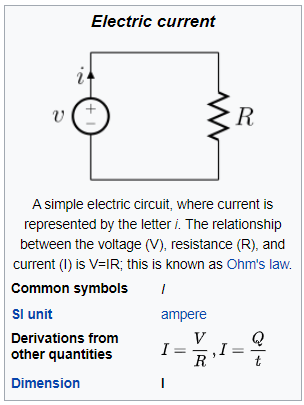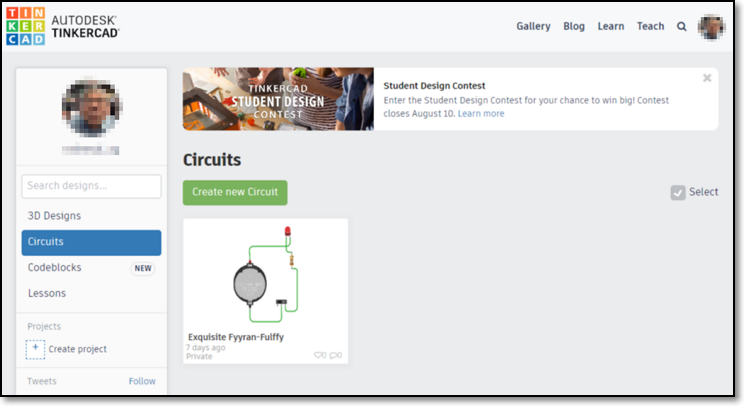<!-- Home, Back using Javascript -->
<div>
<form>
<input type="button" value="Home" onclick="window.location.href='/ep1000digfab/index.html'">
<input type="button" value="Back" onclick="history.back()">
</form>
</div>
<div style="height:2em"></div>
<!-- Remember to change the title of the page -->
# Electronics
[Presentation: Electronics](ep1000_electronics.pdf)
This is a fast and brief introduction to Electronics. We do not attempt to make you electronics engineers or experts, but you should have enough knowledge to connect up a simple circuit successfully as well as use the circuit to measure or output a result.
## Basics
Electricity is the flow of electronics in a closed circuit.
- Voltage is the difference in electrical potential between two points, measured in **Volts**.
- Current is the rate of flow of electrical charge past a point. Current is measured in **Amps**.
- Electrical resistance (or Resistance) of an object is a measure of the opposition to the flow of electric current. Resistance is measured in **Ohms**
- In order for current to flow, the circuit must be **closed**.
[](https://en.wikipedia.org/wiki/Electric_current)
There are two types of electric currents
- AC (Alternating current) where the voltage moves from positive to negative values, *alternating* in time,
+ Home electricity is AC - 230V, 13~15 Amp
+ A bicycle dynamo is AC - 5-9V, 0.1~0.5 Amp (depending on how fast you peddle!)
- DC (Direct current) where the voltage potential is at a fixed value (either positive or negative).
+ AA battery source is DC, 1.5V, 500mA Ref: [Energizer E91](https://data.energizer.com/PDFs/E91.pdf)
+ 18650 LiON battery (used in most laptops, mobile battery packs) is DC 3.7V, 1~2A (You can discharge more, but the batteries catch fire!)
- We will mainly work with DC currents and voltages.
## Two important Electrical Laws
### Ohm's Law
Ohm's law states that **Voltage = Current * Resistance**, or written as
- Voltage = Current x Resistance
- Current = Voltage / Resistance
- Resistance = Voltage / Current
Calculating resistance in a circuit
- Resistors in series, R = R1 + R2
- Resistors in parallel, R = 1/R1 + 1/R2
### Kirchoff's Laws
[**Kirchoff's Laws**](https://en.wikipedia.org/wiki/Kirchhoff%27s_circuit_laws)
Kirchoff's first law (the current law)
- At any junction, or node, in an electrical circuit, the sum of the currents flowing into the node is the sum of the currents flowing out of a node.
Kirchoff's second law (the loop/mesh law)
- When the direction is taken into account, the sum of the potential differences in any closed circuit is zero.
## Electrical Components
Electrical components are broken down into 3 types
- Insulators - prevents current from following
- Conductors - allows current to flow
- Semiconductors - allows current to flow only if some electrical conditions are met.
### Common Electrical components
Here are some electrical components you will encounter
- Wires
- Wires are conductors, usually with very, very low resistance. Usually made up of copper with an insulator on the outside.
- Wires are used for connections and creation of closed circuits.
- The thickness of the wire is measured using [AWG (American Wire Gauge)](https://www.rapidtables.com/calc/wire/wire-gauge-chart.html). The larger the number, the smaller the diameter.
- [Switches](https://en.wikipedia.org/wiki/Switch)
- An electrical component that **breaks** a circuit when manually operated. Usually made up of two contacts separated by a conductor. When the conductor is closed, the circuit is completed.
- Common types of switches
- SPST - Single Pole Single Throw
- Push-to-make
- Push-to-break
- Normally-closed, throw switch to break circuit
- [Resistors](https://learn.sparkfun.com/tutorials/resistors/all)
- an electrical component which has made to have a fixed resistance to current.
- resistors are [color coded(https://www.digikey.com/en/resources/conversion-calculators/conversion-calculator-resistor-color-code-4-band) so that you can identify them
- besides, resistance values, resistors come in different [power ratings](https://www.electronics-tutorials.ws/resistor/res_7.html) to handle the amount of current that can safely flow through.
- [Capacitors](https://learn.sparkfun.com/tutorials/capacitors/all)
- electronic components that can store charge.
- made up of two sheets/plate of conductors separated by an insulator/dielectric, charge is accumulated on each plate
- used as filters
- not essential to our fabrication course
- [Diodes](https://learn.sparkfun.com/tutorials/diodes)
- semi-conductors that allow current to flow ONLY in one direction.
- used for filtering AC
- [LED (Light Emmi ting Diodes)](https://learn.sparkfun.com/tutorials/light-emitting-diodes-leds) are special diodes which give off light when the current flows in the correct direction.
- [Transistors & MOSFETs](https://learn.sparkfun.com/tutorials/transistors)
- semi-conductors that allow current to flow provided an electrical condition is met on one of the pins.
- can be used as amplifiers (non-saturation) or switches (saturation)
- we shall use transistors mainly as electrical switches.
- [Integrated circuits](https://learn.sparkfun.com/tutorials/integrated-circuits)
- devices which are miniaturized electrical circuits. Each IC can contain thousands of other electrical components configured in a particular circuit(c)
- our modern day building blocks
## Measurements
It is common for electrical components to have a prefix (e.g. Kilo) placed in front of the value. The following table shows the significance of each of the terms as applied to resistance, voltages, currents and other electrical values.
| Prefix | Symbol | Base 10 |Decimal |
|----------|:--------:|----------|------------------------------------|
|mega | M | 10^6 | 1 000 000 |
|kilo | K | 10^3 | 1 000 |
| | | 10^0 | 1 |
|mili | m | 10^-3 | 0.001 |
|micro | μ | 10^-6 | 0.0000001 |
|nano | n | 10^-9 | 0.000000001 |
|pico | p | 10^-12 | 0.000000000001 |
&nbsp;
## Learning Electronics
Watch this [Simple Guide to Electronic Components](https://youtu.be/6Maq5IyHSuc) to help you identify the physical electrical components that you may encounter.
A good and simple introduction to electronics can be found at the Open University site [OpenLearn](https://www.open.edu/openlearn/) - [An Introduction to Electronics](https://www.open.edu/openlearn/science-maths-technology/introduction-electronics/content-section-0?active-tab=content-tab). After finishing this very short course you may also print out a certificate of attendance!
However, most students like the harder and more practical method of learning by doing, as such you have the site [TinkerCAD by Autodesk](https://www.tinkercad.com/). You can sign in with your Autodesk account.
[](https://www.tinkercad.com/dashboard?type=circuits)
Under TinkerCAD, you have [Circuits](https://www.tinkercad.com/dashboard?type=circuits) which allows you to design, tinker and test your circuits before you implement them physically. This tool greatly enhances the learning experience in Electronics.
&nbsp;
## References:
1. OpenUniversity OpenLearn [An Introduction to Electronics](https://www.open.edu/openlearn/science-maths-technology/introduction-electronics/content-section-0?active-tab=content-tab)
2. [Sparkfun tutorials](https://learn.sparkfun.com/)
3. [TinkerCAD](https://www.tinkercad.com)
4. EngCS Youtube Videos:
- [Introduction to TinkerCAD Circuits](https://youtu.be/38ur1kyFYxc)
- [Introduction to TinkerCAD Digital](https://youtu.be/LHfqgct69bs)
- [Introduction to Function Generator & Oscilloscope](https://youtu.be/wfvYz1L0Qkk)
5. Dennis Humphrey [Making series and parallel circuits using Tinkercad](https://youtu.be/upuGkCdGEKA)
<!-- Home, Back using Javascript -->
<div style="height:2em"></div>
<div>
<form>
<input type="button" value="Home" onclick="window.location.href='/ep1000digfab/index.html'">
<input type="button" value="Back" onclick="history.back()">
</form>
</div>
<!--End of markdown area-->